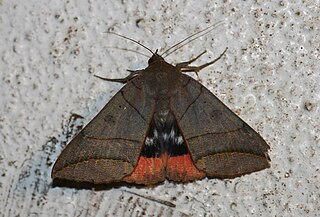
Naarda is a large genus of erebid moths currently encompassing 108 species. Initially identified by Francis Walker in 1866, it is in the family Erebidae. Somewhat ruddy in appearance, this genus is distinguishable for its generally slender thorax and abdomen, and straight, porrect labial palpi. Most species are a light tan color, but shading can reach as deep as a charcoal, with muddy yellow, conspicuous reniform, orbicular stigmata featured on the forewings, sometimes reflected bilaterally superior.

Lyssa zampa, the tropical swallowtail moth or Laos brown butterfly, is a moth of the family Uraniidae. The species was first described by British entomologist Arthur Gardiner Butler in 1869.
Mosopia is a genus of moths of the family Erebidae. It is found in south-east Asia, including Thailand, Borneo and Malaysia. The genus was first described by Francis Walker in 1866 from a specimen in the British Museum. The specimen Walker describes was from Penang in Malaysia.

Thyas juno is a species of moth of the family Erebidae first described by Johan Wilhelm Dalman in 1823. It is found in the Indian subregion, China, Japan, Korea, Thailand, Borneo, Java, Sulawesi and on the southern Moluccas.

Bastilla crameri is a moth of the family Noctuidae first described by Frederic Moore in 1885. It is found from the Indian subregion to Sri Lanka, Peninsular Malaysia, Japan, Sumatra and Borneo. It is also present in South Africa.

Pindara illibata is a moth of the family Noctuidae first described by Johan Christian Fabricius in 1775. It is found in the Oriental region, including Taiwan, China, India, Sri Lanka, Myanmar, Japan and Borneo.

Nyctemera adversata, the marbled white moth, is a moth of the family Erebidae first described by Johann Gottlieb Schaller in 1788. It is found in Sri Lanka, Bangladesh, India, Nepal, Myanmar, China territories like Tibet, Sichuan, Yunnan, Guangdong, Hong Kong, Hainan, Guangxi, Hunan, Henan, Zhejiang, Jiangxi, Fujian, Taiwan, Japan, Peninsular Malaysia, Thailand, Indonesia Philippines.

Asota egens is a species of noctuoid moths in the family Erebidae. It is found from Japan and the Oriental tropics, east to New Guinea.

Pogonopygia nigralbata is a moth of the family Geometridae. It is found in Peninsular Malaysia, Sumatra, Borneo, Japan, the north-eastern Himalaya, northern Vietnam and Luzon.

Milionia basalis is a moth of the family Geometridae first described by Francis Walker in 1854. It is found in Japan, the north-eastern parts of the Himalayas, Myanmar and Sundaland.

Nyctemera lacticinia, the common nyctemera, is a moth of the family Erebidae. The species was first described by Augustus Radcliffe Grote in 1873. It is found in Japan, from the Oriental tropics of India, Sri Lanka, Myanmar to Taiwan, Peninsular Malaysia and Borneo.

Asthenini is a tribe of geometer moths under subfamily Larentiinae first described by Warren in 1893. The tribe has been combined with Eupitheciini in the past, most notably by Jeremy Daniel Holloway in his work The Moths of Borneo.

Pericyma cruegeri, the poinciana looper, is a moth of the family Erebidae. The species was first described by Arthur Gardiner Butler in 1886. It is found in south-east Asia including Hong Kong, Taiwan, Vietnam, Thailand, Sumatra, Peninsular Malaysia, Borneo, the Philippines, New Guinea, and in Australia, northern New South Wales and Queensland. Furthermore, it is an introduced species in Hawaii and Guam, where it was first detected in 1971. In Japan, it was first detected in 1986 in Ishigaki Island and the living area is expanded to Okinawa Island by 2000.
Meganola brunellus is a moth of the family Nolidae. It is found in Sri Lanka, India, Taiwan, Japan, the Ryukyu Islands, Sundaland, Queensland and the Bismarck Islands. It is an introduced species in Hawaii.

Corymica pryeri is a species of moth of the family Geometridae first described by Arthur Gardiner Butler in 1878. It is found in Japan, Taiwan, the north-eastern Himalayas, Sumatra, Borneo, New Guinea and possibly Queensland, Australia.

Creatonotos transiens is a moth of the family Erebidae. The species was first described in Western literature by Francis Walker in 1855.

Dilophodes elegans is a moth in the family Geometridae first described by Arthur Gardiner Butler in 1878. It is found in Japan, China, Taiwan, north-eastern Himalaya, Burma and Borneo.

Pogonopygia pavida is a species of moth of the family Geometridae. It is found in the Himalaya, Taiwan, Japan, Indonesia and Peninsular Malaysia.

Comostola subtiliaria is a moth of the family Geometridae first described by Otto Vasilievich Bremer in 1864. It is a widespread species which is found in Korea and adjacent parts of Siberia, Japan, Borneo, Sumatra, India, South China, Taiwan, Borneo, Sumatra, and Sri Lanka.

Thalassodes immissaria is a moth of the family Geometridae first described by Francis Walker in 1861. It is found in the Oriental tropics of China, India, Myanmar, Sri Lanka, Hong Kong, Japan, Borneo, Vietnam, Sumatra, Sulawesi and the Ryukyu Islands. The populations in Ryukyu were often classified as a subspecies - Thalassodes immissaria intaminataInoue, 1971. However, in 2005 this subspecies was upgraded to a distinct species, which can be distinguished from immissaria by careful examination of the male genitalia.



















